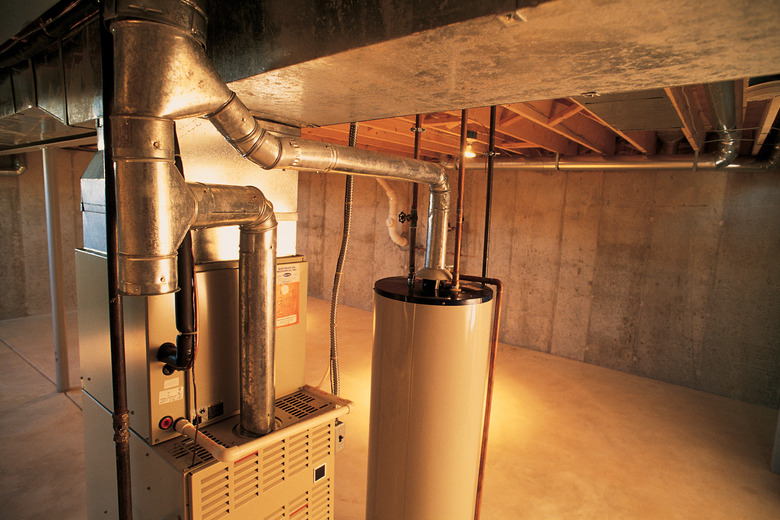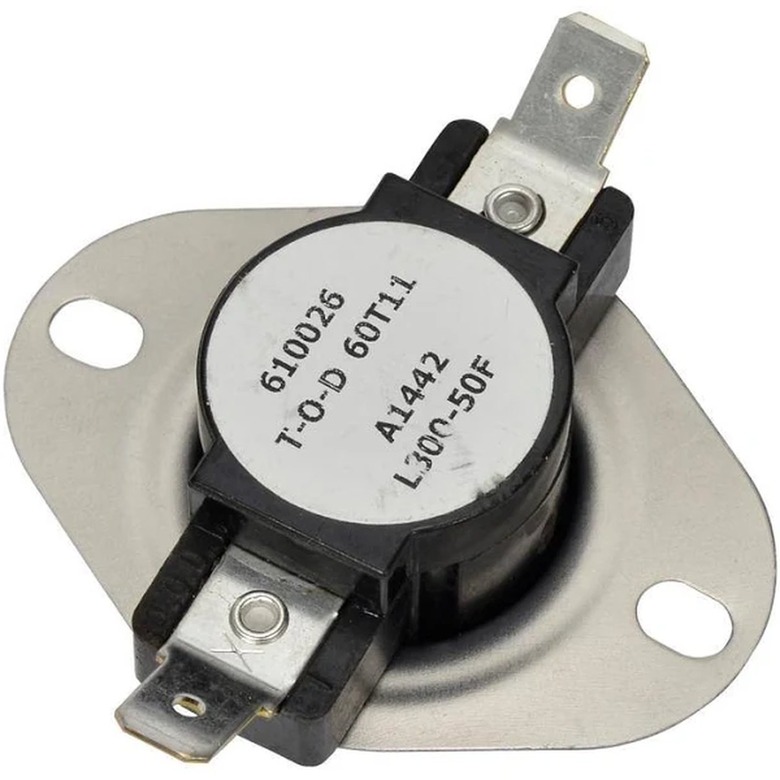How To Replace A Furnace Limit Switch — And How To Tell It's Gone Bad
We may receive a commission on purchases made from links.
When your furnace malfunctions, there are four best-case scenarios for the repair, and replacing the limit switch is one of them. Like the flame sensor, the furnace limit switch mounts to the side of the burner enclosure, and it's in plain sight and easily accessible when you remove the furnace cover. If you have the new limit switch in hand, the entire replacement procedure will take you about five minutes, and you'll be paid handsomely for your DIY prowess. An HVAC pro would charge anywhere from $150 to $400 to do the job, so subtracting the cost of the switch, which is between $12 and $50, you're saving a minimum of $100 if you do the job yourself. Not bad!
But first, you want to make sure that the job is necessary because even five minutes invested in a procedure that doesn't fix the problem is a waste. A homeowner can identify a bad limit switch in one of two ways: by observing the nature of the furnace malfunction and by using a multimeter to test the switch. The test is a good idea, but you may be able to skip it because the symptoms of the malfunctions caused by a bad limit switch are often a dead giveaway. One more thing to remember is that limit switches are sometimes resettable, and replacement may be unnecessary.
What Does the Limit Switch Actually Do?
What Does the Limit Switch Actually Do?
Furnaces actually need two limit switches that perform different functions, and these are often rolled into a combination switch that does both. The fan limit switch monitors the temperature in the plenum, which is the large space at the top of the furnace housing where the ductwork is attached. When the plenum fills with warm air, the switch, which is normally open, closes to activate the furnace blower. The fan limit switch, therefore, prevents the furnace from blowing cold air, and it will stay closed until the temperature falls to its set point to distribute as much warm air as possible throughout the house. If you've been wondering what makes the blower stay on after the furnace goes off, it's the fan limit switch.
The purpose of the second limit switch, known as the high limit switch, has more to do with safety than comfort. Its location at the top of the combustion chamber, just above the heat exchanger, enables it to measure the air temperature inside the plenum, and when the temperature exceeds its set point, it switches off the gas. If the heat exchanger were allowed to overheat, it could crack and release toxic gases into the furnace room, such as carbon monoxide. The purpose of the high limit switch is to prevent this and other damage, not to mention a potential fire.
Even though a heat pump or air conditioning system doesn't have a combustion chamber, it still usually has a limit switch. In an air conditioner or a heat pump (which is essentially an air conditioner working in reverse), the limit switch is the link between the air handler and the room thermostat. When the thermostat signals the air conditioner to shut off, the limit switch shuts off the blower, thereby assuring that unconditioned air isn't being circulated throughout the house.
Symptoms of a Failed Limit Switch
Symptoms of a Failed Limit Switch
The fan limit switch in a furnace deteriorates with age, and it may operate sluggishly or get stuck. If it gets stuck in the open position, the blower won't come on, and the furnace will quickly overheat and trigger the high limit switch, with the ultimate result being that the furnace won't work. If it gets stuck in the closed position, the blower will keep running after the plenum has cooled down, and cold air will come through the registers into the house. Brrr — not exactly fun on a cold day!
Whereas the fan limit switch controls the blower motor, the high limit switch controls the gas valve. The high limit switch is normally closed, which means it's allowing current to flow, but when it senses a temperature above its set point, it opens, shutting off power to the gas valve. When the temperature in the plenum falls below the set point, it closes again, and the gas valve opens, but if the temperature again rises past the set point, the high limit switch shuts off the gas again.
Repeated cycling on and off is bad for the furnace, and to prevent permanent damage, the furnace goes into hard lockdown mode if it cycles on and off too frequently (three times is usually the limit), and you may need a service pro to start it up again. If you can't start your furnace at all, it may be because the high limit switch tripped too often because of overheating. You can prevent overheating by tuning up the furnace on a regular basis. On the other hand, the furnace may not be overheating at all; the high limit switch may simply be faulty and may need to be replaced.
Things Needed
-
Mobile device
How to Replace a Limit Switch
1. Remove the Access Cover
You may need to remove some screws using a Phillips screwdriver to get the front cover off, but most modern furnaces have plastic knobs that you can turn with your fingers. After removing all the fasteners, lift the cover straight off and set it out of the way.
2. Locate the Limit Switch
The burner assembly is right in front of you, and near the top, you'll see two wires connected to a device fastened to the side of the assembly. This is the limit switch, not to be confused with the flame sensor, which has to contact the burner flame, so it's installed below the limit switch. If the limit switch has a reset button and the button has popped out, press it in until it clicks. That may resolve the problem.
3. Conduct a Voltage Test
Set a multimeter to read DC voltage and touch the meter leads to the two terminals on the limit switch. The voltage drop should be less than 0.1 VDC, and if it's 0.2 VDC or higher, the switch is bad. A reading between 0.1 and 0.2 VDC indicates that the switch is weak but hasn't failed completely, though you should replace it to be on the safe side.
4. Turn Off the Power
Turn off the power to the furnace at the shutoff switch if there is one. Otherwise, turn off the circuit breaker to the furnace circuit in the main panel (breaker box). Turn off the gas supply to the furnace by turning the handle of the in-line supply valve 90 degrees until it's perpendicular to the gas line.
5. Disconnect the Switch
Using your mobile device, take a picture of the wire leads to be sure to put them back on the same terminals after you replace the switch. The switch wires are interchangeable, which makes miswiring almost impossible, but having a picture in hand covers all the bases and prevents confusion. Pull the wires off the switch. They are held on with spade connectors, so they should slide right off, although you may have to exert a fair amount of force if they're stuck.
6. Unscrew and Remove the Switch
Remove the screws holding the switch to the burner chassis. There may be two, three or four, and you'll need a Phillips screwdriver or a socket wrench to unscrew them depending on the screw heads. Remove the switch.
7. Install a New Switch
Install an identical switch by poking the probe through the opening, pushing the plate tight against the burner chassis and driving in the screws. Reconnect the wires using the picture you took as a reference if you aren't sure where they go.
8. Replace the Furnace Cover
Slide the furnace cover into place and tighten the connectors or drive the screws needed to hold it in place.
9. Turn the Furnace Back On and Test It
Turn on the power and then open the gas line to the furnace. Set the room thermostat to a high setting to force the furnace to come on and make sure it's operating normally.
Purchasing a Replacement Switch
Purchasing a Replacement Switch
Limit switches vary in design, and the temperatures at which they open (cut out) and close (cut in) are different for each gas furnace, so it's important to get the right one. The best way to do this is to write down the make, model and serial number of your furnace. This information should be enough to get the switch you need online at a retailer such as RepairClinic.com or eReplacementParts.com, or you can take the information to your local HVAC dealer. You probably won't find what you need at a standard hardware or big-box store.
The cut-in and cut-out temperatures are vitally important, and they are usually marked on the switch. Do not try to substitute a switch that looks the same but has different cut-in and cut-out temperatures. The furnace won't work properly, and overheating could damage it or start a fire.
Troubleshooting a Furnace Shutdown
Troubleshooting a Furnace Shutdown
Depending on the model, a hard lockdown only lasts for a short period (usually an hour), after which it will start working again. During the time that it's off, there are a couple things you can do that may prevent it from overheating and going back into lockdown. The first is to replace or clean each and every air filter because if the filters are dirty and hindering airflow, the furnace is sure to overheat again. The second is to remove the furnace cover and clean the blower fan with a soft brush or compressed air. Dust buildup may be preventing the blower fins from spinning.
You can also test the limit switch with the power off. Set your multimeter to the most sensitive resistance scale in ohms (Ω), pull the connectors off the limit switch and touch the meter leads to the terminals. If you get an infinite resistance reading, which a digital meter displays as OL, the switch is bad, so you'll want to replace it. If you get a reading of zero or close to zero, the switch is working, but that doesn't mean you don't need to replace it. If it's old, it could have deteriorated to a point at which it opens at a lower temperature than it's supposed to, thinking the furnace is overheating when it isn't.
After you've completed these procedures and the power comes back on, the furnace may operate normally, and if so, you've fixed the issue! If it begins cutting out again, that's a strong indication that the high limit switch is bad and needs replacing. At this point, it's best to shut off the furnace before it goes into lockdown again and go ahead and replace the switch.
References
- Angie's List: 4 Best-Case HVAC Repairs for a Broken Furnace
- Carney Plumbing, Heating, Cooling: What Are Limit Switches and How Do They Work?
- Comfort Flow Heating: What You Need to Know About the Limit Switch
- Dinosaur Electronics: Limit Switch Testing
- YouTube: HVAC Repair Guy – Gas Furnace Limit Switch Troubleshooting & Replacement

